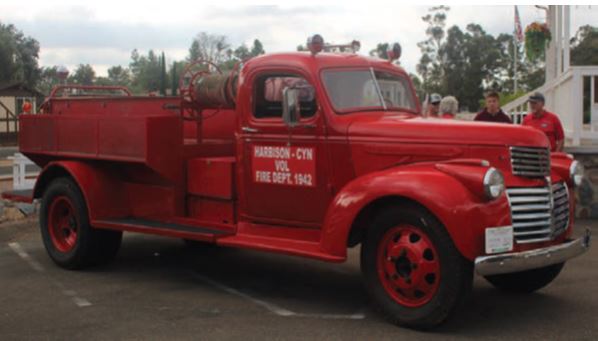
Alpine Historical Society lured members of the community to an Oct. 16 talk on fire prevention with several historic red fire trucks parked prominently in front of the old town hall alongside their modern counterpart.
“Sometimes, the historical equipment triggers curiosity,” AHS President Tom Myers said, a draw to pull in residents for a seasonal fire talk.
Alpine Firefighter Chip Howell kicked off the lecture with a quick summary of how he came to own a circa-1942 fire truck which originally worked out of Twin Lakes, Wisconsin after reading about it in ‘Old Cars Weekly’ and submitting an auction bid.
“I got there and the fire chief said ‘there’s your fire truck’ but I still had to get it home so I slept in the patient litter on the drive back,” Howell said.
His 1942 pumper along with an original 1952 Harbison Canyon Volunteer fire truck donated to the historical society, and a 1931 Ford modified to run on train rails were all on scene outside while Alpine Fire Protection District firefighter-paramedic Joe Lavigne gave a talk on fire prevention to roughly 25 attendees inside.
Connecting the historic vehicles with the reality of modern day fires, Lavigne reminded attendees of major fires which have struck the area over the past 50 years: the 1970 Laguna fire, 2001 Viejas fire, 2003 Cedar fire, 2005 Witch/Harris fires, 2018 West fire and the 2020 Valley fire.
California State Assembly bill 3074, which will take effect in January 2023 addresses defensible space in high fire hazard areas, Lavigne explained. AB 3074 officially recognized a new ‘zone 0’ of defensible space which runs from the exterior wall to five feet out around the perimeter of a structure.
That new zone should be hardened so embers are less likely to develop into a home fire, Lavigne said, not just in new construction but in established homes as well. Four key components need to be addressed in establishing defensible space around a home, he said: vegetation, vents, windows and other openings, and fences.
“I don’t want you to drop a bunch of hundred-year old oaks but we do want you to reduce fuel,” Lavigne said.
Changing out the five immediate feet around a home perimeter won’t necessarily be cheap or easy, he cautioned but it is important to clear away anything that can serve as fuel for a fire where it can easily spread those five feet and reach a vulnerable structure.
He also said residents need to make wise choices about where they are dedicating time and money as they begin creating a safer perimeter in defensible zones.
“I’d much rather have someone have clear access to their house. If I come past your driveway and it looks like The Jungle Cruise out there, I can’t get a truck or an apparatus in,” Lavigne said.
Newer homes, he said, are typically built with eaves and vents boxed in so embers won’t invade and ignite an attic but older homes should have their vents replaced. Similarly, older windows should be replaced with newer, more protective windows and wooden fences which come within five feet of a home or touch the exterior should be changed out.
“A lot of people are removing those old, wooden fences and going to wrought iron so they don’t have fire potential,” Lavigne said.
During time for questions, several residents asked about other ways they might be able to protect their homes in the modern age of year-round fires such as whether taking the time to shut down Tesla electric car systems installed at some homes would be helpful.
“I wouldn’t worry about securing your batteries, just get out. Utilize the time for something else,” Lavigne said.
Applying fire retardants to a home proves tricky in the timing, the firefighter said as anything applied too far in advance of a fire is going to pointlessly dry out and anything applied in the immediate path of a fire puts residents at risk of getting stuck rather than safely evacuating.
“Ultimately, we want to make sure you’re out of there,” Lavigne said.
Although he said the state might realize there are homeowners who are not physically capable of making changes or cannot afford to hire someone to do the work, he did not have any suggestions for where residents can seek out help beyond the annual Sunrise Powerlink grant.
He also said there is a balance to be had: eliminating all trees in a yard reduces the shade canopy and could potentially increase temperatures which is a step in the wrong direction for energy conservation. However, he also said residents need to make sure they are aware of changes in the law and can keep their fire insurance.
“The ultimate goal is to reduce the vulnerability of homes to embers,” Lavigne said.
Back outside, the 1931 Ford modified to run on rails and protect the wooden train trestle near Jacumba against fire departed for the Pacific Southwest Railway Museum in Campo where it has remained on loan from the California State Railroad Museum in Sacramento since a pre-pandemic event.
Howell then fired up the 1942 pumper and, proudly proclaiming the truck has “low mileage”, gave a quick burst of the still functional siren before pulling out ahead of the modern AFPD truck.











